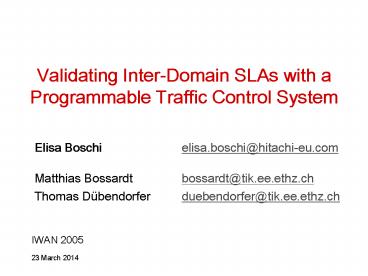Validating Inter-Domain SLAs with a Programmable Traffic Control System - PowerPoint PPT Presentation
Title:
Validating Inter-Domain SLAs with a Programmable Traffic Control System
Description:
11/10/09. Validating Inter-Domain SLAs with ... require a minimum level of performance. Negotiated in Service Level Agreements ... 5 GOLDEN RULES (explaination) ... – PowerPoint PPT presentation
Number of Views:21
Avg rating:3.0/5.0
Title: Validating Inter-Domain SLAs with a Programmable Traffic Control System
1
Validating Inter-Domain SLAs with a Programmable
Traffic Control System
- Elisa Boschi elisa.boschi_at_hitachi-eu.com
- Matthias Bossardt bossardt_at_tik.ee.ethz.ch
- Thomas Dübendorfer duebendorfer_at_tik.ee.ethz.ch
IWAN 2005
2
MOTIVATION
- Services (VoIP, multimedia streaming) require a
minimum level of performance - Negotiated in Service Level Agreements
- When Service Level Agreements cross ISP
boundaries - how to validate the compliance of network
services to the guarantees in an SLA - Problems
- ISPs have minimal information about
characteristics and performance of other networks - Performance of specific path portions
3
SCENARIO (jitter measurement)
- ? Requires dynamic configuration of devices
located in different domains - Major security concerns
4
HOW CAN WE ACHIEVE THIS
- Deploying measurement logic on distributed
programmable Traffic Processing Devices (TPDs) - Attached to routers
- Located in several Autonomous Systems
- Almost abitrary service logic (flexibility)
- Configuration on-demand of TPDs on the end-to-end
path - Delegation of partial management capabilities to
network users - Security against misuse...
5
GOLDEN RULES
- TRAFFIC OWNERSHIP traffic control is restricted
to the owner of source IP address or
destination IP address - Source and destination IP addresses cannot be
modified - The TTL field of IP packets cannot be modified
- The packet rate must not increase.
- The amount of traffic leaving the TPD must be
equal or less than the amount of traffic entering
it.
6
TRAFFIC CONTROL SYSTEM (TCS)
- A user registers with the Traffic Control Service
Provider (TCSP) - The TCSP manages the Traffic Control services
- Checks users identity
- Verifies the IP Addresses ownership with Internet
Number Authorities - Sets up contracts with ISPs
- ISPs attach Traffic Processing Devices to (some
of) their routers - Enable their network management system to program
and configure them
7
NODE ARCHITECTURE
- The router is extended with a programmable
Traffic Processing Device (TPD)
8
DEPLOYMENT PROCESS
- The deployment process is subdivided in layers
- For each service a layer offers, a service
descriptor specifies - The mapping to sub-services
- Mandatory and optional parameters
- Restrictions
- Deployment logic on each layer maps the service
request to services provided by the layer below - Based on service descriptors
9
SERVICE REQUEST
10
DELAY VARIATION DEPLOYMENT (1/2)
- The service offered by the TCSP and the required
parameters are described in a service descriptor - The service request contains
- User identification
- Parameter values
- src and dest address
- Uplink I/F of A to ISP1
- Downlink I/F from ISPn to Z
- Collector address
- .
11
DELAY VARIATION DEPLOYMENT (2/2)
- The TCSP
- selects the ISPs according to the Restrictions
- BGP path from A to Z
- AS numbers are taken from the Context Database
- Maps the request to sub-services
- The ISPs
- select the Traffic Processing Devices
- Only on egress routers from prevAS to next AS
and on uplink and downlink I/Fs
12
SERVICE COMPONENTS
- deployed on all TPDs
- Timestamp, packet ID, paket size are exported to
the collector
13
CONCLUSIONS
- Guarantees given in an inter-domain SLA can be
validated - Measurement services are executed on a
programmable TCS - The TCS safely delegates partial control over
TPDs to network user - Measurement logic is deployed to TPDs in
different ASs - Highly modular (? reusability of components)
- Secure against misuse (golden rules)
- Other metrics possible
- Other services possible (DDoS mitigation)
14
SCALABILITY CONSIDERATIONS
- Scaling factors
- service subscribers
- ISPs deploying the service
- service components installed / user
- Bandwidth
- ? Service logic and state per TPD
- Memory needed is modest
- ? Signalling effort
- Small messages to few thousands ISPs not a
bottleneck - ? Traffic processing capacity
- HW solutions (FPGA) allow packet filtering at
10Gbps
15
STATE OF THE ARTin inter-domain measurement
- NIMI SW system for building measurement
infrastructures. Tools can be added (wrapper) - IPMP Active measurement protocol based on packet
probes suited to measure delay at router level - 6QM Measurements are configured by sending an
XML-based document to controllers on the
end-to-end path - Generally missing
- Flexible system to automatically deploy the
service to the appropriate device - Adequate guarantees for network data privacy and
against misuse
16
INTER-DOMAIN QoS MODELS
- BILATERAL
- 2 providers interconnect at one or more points
and agree on a set of metrics, methods... - Just 2, no reausability
- COOPERATIVE
- Set of rules a cooperating group of ISPs has to
follow - Standards needed
- THIRD-PARTY
- Composes end-to-end results, responsible for
site-to-site measurement - More flexible
17
OUTLINE
- Motivation
- Scenario inter-domain jitter measurement
- Traffic Control System
- Node Architecture
- Deployment process
- Conclusions
18
BACK TO THE SCENARIO JITTER MEASUREMENT
19
components
20
SERVICE REQUEST
21
5 GOLDEN RULES (explaination)
- Such rerouting could wreak havoc easily (causing
routing loops, interference with other routing
mechanisms, transparent source spoofing, or
forwarding of attack traffic). - as it aims to set an upper bound of network
resources a packet is able to use. - we need to prevent that the service can cause
amplifying network-like effects. - The amount of the network traffic leaving the
traffic processing device must be equal or less
compared to the amount of traffic entering it.
I.e. packet size may only stay the same or become
smaller.































